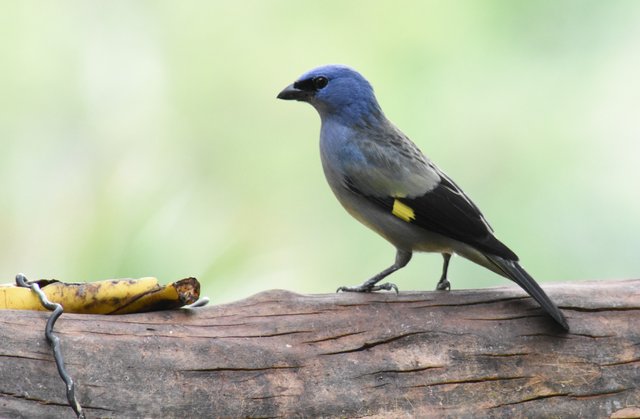Guatemala Day 2
Tennessee Warbler Leiothlypis peregrina We tend to think of the wood warblers as our ABA birds. In reality they only visit North America for a few months each year to breed, and live the rest of the year south of our area. Here in Guatemala many of "our" birds are common all winter in mixed species flocks.
A quick post and a few photos from Day 2 of my Guatemala trip. Today we got up and were on the road from Antiqua by 5:45 AM and headed straight for our first birding spot of the day. It was at Rincon Suizo, a private reserve off the Pan American Highway at about 7000 feet elevation. It also happened to be the place for our restaurant for breakfast and dinner. As a vegan I’m primarily ordering a set of “extras” or side dishes on the menu to create a meal, as pre-designed vegan options are often not available. Fortunately place we have stopped on the trip has been happy to help, and today I ordered what seemed like a hearty but reasonable breakfast. A fruit bowl, a side order of black beans and corn tortillas, and toast and jam from a wonderful native blueberry like plant. When it arrived the fruit bowl was enormous, and there were three split rolls toasted, each roll about the size of a normal bagel, and the beans were a generous size order. Needless to say I ate all I wanted and left plenty behind.
We plant many cultivars of dahlias in our gardens at home. Here they grow wild. This is a "White Dahlia."
On the trail above the restaurant was an oak-pine habitat with some man-made clearings, perfect for looking for higher elevation specialties. As has been the case we looked for mixed flocks of birds, and had very nice success, though photo opportunities were limited. Pink-headed Warbler was probably the highlight of my morning, though the Blue-throated Motmot had to be close behind, and the Amythyst-throated Hummingbird was awesome, though looks always brief. Mexican Violet-ears, a hummingbird, were seemingly calling everywhere. Claudia explained that these are a hummingbird that breeds on a lek. This means that the males sit and display and call, while the females choose whom to mate with. This made them very easy to hear, and nearly impossible to see. We estimated 12 birds, but it seemed like dozens to me.
Yellow-winged Tanagers Thraupis abbas were among the most common species at Los Torrales. This one was at their fruit feeding station.
After another “too-much-to-eat” lunch we undertook a tedious drive to Los Torrales, a famous birding reserve near Lake Atitlan, at lower elevation, and got here about 3:30 PM. After a brief rest, we birded until dark. This is a much different avifauna here, and we quickly found a number of new species, and though the light was waning, the birds here were more obliging for photos. Here are a few of my favorite.
These Gray Silky-flycatchers Ptiliogonys cinereus were everywhere on many stops. You have to love birds that are loud and like open perches. It's especially nice when they are really beautiful.
Good birding. Steem on!




You got a 26.51% upvote from @booster courtesy of @birdbanter!
NEW FEATURE:
You can earn a passive income from our service by delegating your stake in SteemPower to @booster. We'll be sharing 100% Liquid tokens automatically between all our delegators every time a wallet has accumulated 1K STEEM or SBD.
Quick Delegation: 1000| 2500 | 5000 | 10000 | 20000 | 50000